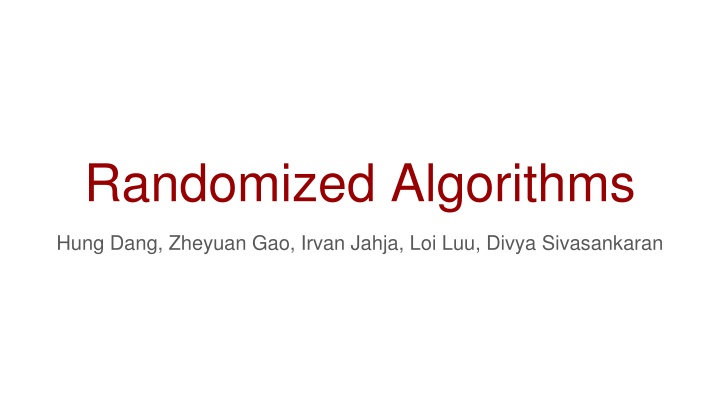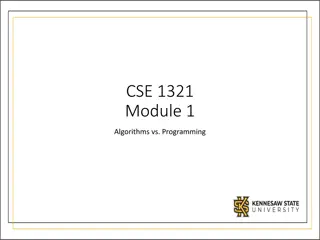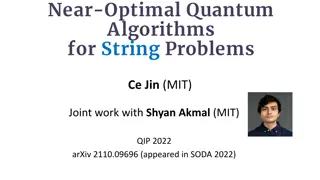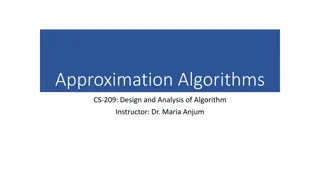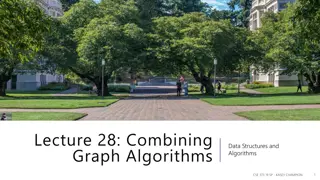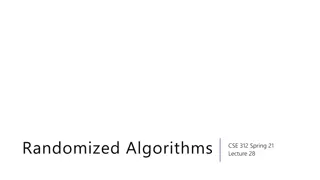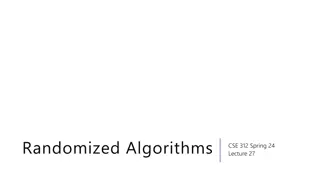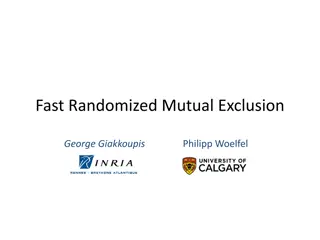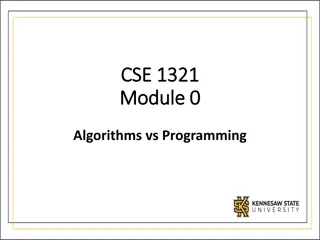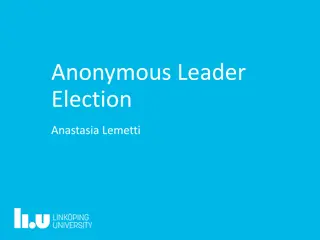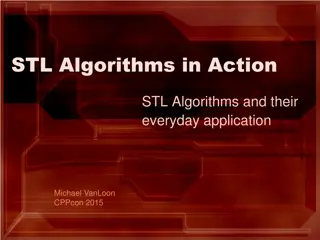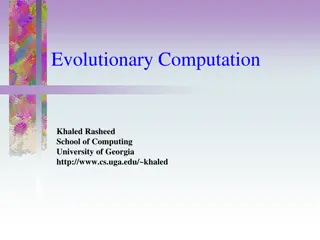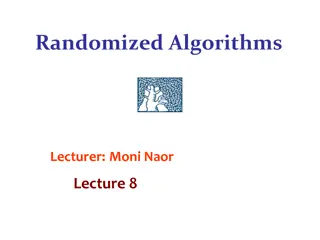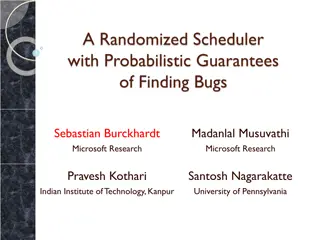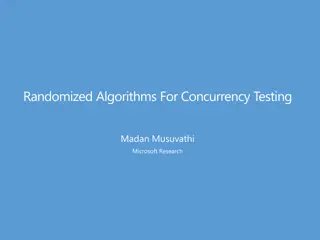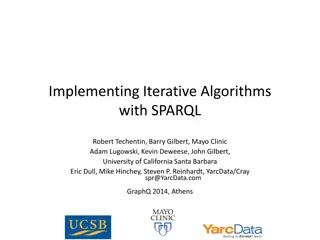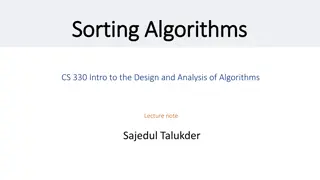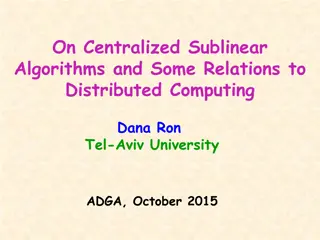Randomized Algorithms
This content delves into the intricacies of using randomized algorithms to tackle the challenge of counting perfect matchings in dense bipartite graphs. It explores the complexity of the problem, its connection to the permanent of the adjacency matrix, and the relationship between perfect matchings and #P-complete problems. The discussion covers concepts like approximation algorithms, probabilistic algorithms, and the properties of perfect matchings in graphs.
Download Presentation

Please find below an Image/Link to download the presentation.
The content on the website is provided AS IS for your information and personal use only. It may not be sold, licensed, or shared on other websites without obtaining consent from the author.If you encounter any issues during the download, it is possible that the publisher has removed the file from their server.
You are allowed to download the files provided on this website for personal or commercial use, subject to the condition that they are used lawfully. All files are the property of their respective owners.
The content on the website is provided AS IS for your information and personal use only. It may not be sold, licensed, or shared on other websites without obtaining consent from the author.
E N D
Presentation Transcript
Randomized Algorithms Hung Dang, Zheyuan Gao, Irvan Jahja, Loi Luu, Divya Sivasankaran
Agenda DNF Counting Problem Approximating the Permanent Reduction to near uniform generation Near-Uniform Generation of Matchings Canonical Path Argument
Introduction Hung Dang
Our problem Counting the number of Perfect Matchings in a (dense) bipartite graph. Each vertex has a degree of at least n/2 (n is number of vertices). Number of perfect matching in a bipartite graph is equal to the permanent of the adjacency matrix representing the graph
Background Counting problem asks for the number of solutions to a given decision problem as hard as the corresponding decision problem #P Problem Counting problem associated with the decision problems in NP #P-complete Problem A problem is #P-complete if any other problem in #P can be reduced to it in polynomial time
Background Randomized Algorithm employs a degree of randomness as part of its logic uses uniformly random bits as an auxiliary input good performance in the "average case" Probabilistic Algorithm A randomized algorithm which may output incorrect result or even fail to give an answer Approximation Algorithm Return the solutions to optimization problem Approximation ratio is that the ratio between the result obtained by the algorithm and the optimal solution
Perfect Matching A matching (aka independent edge set) on a graph G = (V, E) is a subset of E such that no two edge in the subset share a vertex in common. A perfect matching (aka complete matching or 1-factor) of a graph is a matching in which every vertex of the graph is incident to exactly one edge of the matching. containing n/2 edges (the largest possible) finding a perfect matching is in P
Perfect Matching in Bipartite Graph Nevertheless, finding the number of perfect matching is not believed to be in P. Rather, it is #P-complete to count this number. Interestingly, number of perfect matching in a bipartite graph is equal to the permanent of the adjacency matrix representing the graph bipartite graph: vertices can be divided into two disjoint sets U and V such that every edge connects a vertex in U to one in V.
Permanent of a matrix The sum here extends over all elements of the symmetric group Sn
Permanent of a matrix Expanding along the first column
Permanent of a matrix Expanding along the last row
Definitions A polynomial approximation scheme (PAS) for a counting problem is a deterministic algorithm that takes an input instance I and a real number > 0, and in time polynomial in n = |I| produces an output A(I) such that (1 - ) #(I) A(I) (1 + ) #(I) A fully polynomial approximation scheme (FPAS) is a PAS whose running time is polynomially bounded in both n and 1/ .
Definitions A polynomial randomized approximation scheme (PRAS) for a counting problem is a randomized algorithm that takes an input instance I and a real number > 0, and in time polynomial in n = |I| produces an output A(I) such that Pr[(1 - ) #(I) A(I) (1 + ) #(I)] 1- A fully polynomial randomized approximation scheme ( , )-FPRAS is a PRAS whose running time is polynomially bounded in n, 1/ , and log 1/
DNF Counting Zheyuan Gao
The DNF Counting Problem Disjunctive normal form(DNF): F(X1,X2...Xn)=C1 C2... Cn, Ci=L1 L2... Lri,Ljis either Xkor Truth assignment: x=(x1,...,xn) satisfies F(x1,x2...xn)=1 or True. #F: Number of distinct satisfying assignments of formula F(0<#F 2n) DNF Counting Problem: Compute the value of #F. Attemption of construct ( , )-FPRAS for this problem.
An Unsuccessful Attempt Abstract Problem: Let G be the set of all true assignments for F. We need to estimate |G| Solution:Classical Monte Carlo Method Z: Estimation of size of truth assignments. U: Set of all assignments. F:U {0,1} ?? ? ? Z= |?| ?=? Yi: equals 1 if F(u1)=1, and 0 otherwise. Monte Carlo works by N: Number of total attemption of assignment tests. Sampling from a distribution Y to estimate it s mean Higher sampling leads to higher accuracy How many samples do we need to take to guarantee 1- accuracy?
An Unsuccessful Attempt How many samples do we need to take to guarantee 1- accuracy? Let =|G|/|U|, using Chernoff bound, we can derive that: 4 2 ? ? ?2?ln with probability at least 1- provided
An Unsuccessful Attempt Chernoff bound for the sum of independent Bernoulli trials: ? Let ? = ?=1 ??where Xi=1 with probability piand Xi=0 with probability 1-pi Upper Tail: ? ? 1 + ? ? ? ?2 2+??Lower Tail: ? ? 1 ? ? ? ?2 2? Using Chernoff bound we can derive that Pr 1 ? G Z 1 + ? = Pr 1 ? N Z 1 + ?? = 1 ? ? 1 + ? ?? ? ? 1 ? ?? 1 2 ? ???2 4
An Unsuccessful Attempt 1. It has a running time of at least N, where N 1/ , but we don t know . ( =|G|/|U|) 2. The running time is inversely proportional to , and at least for the DNF counting problem this could be exponentially large.
Why naive Monte Carlo doesnt work? 1. When the fraction of true assignments is very small compared to all assignments(e.g., 2-n fraction), then it is unlikely that we will ever successfully sample a true assignment. 2. We will incorrectly approximate the number of true assignments to be zero. 3. According to ( , )-FPRAS, 0 is an incorrect approximation to any positive value.
Fundamental Issue with Monte Carlo 1. Does not work if the fraction we want to approximate may be extremely small. 2. We will later use Monte Carlo to approximate something else that will either be zero, or be not very small. 3. In this case, Monte Carlo method will yield good approximation.
The Coverage Algorithm Reducing the size of sample space? We will solve a slightly different problem: Union of sets and use it to estimate Let V be a finite universe, giving n subsets H1H2...Hm V For all i, |Hi| is computable in polynomial time. It is possible to sample uniformly at random from any Hi For all v V, it can be determined in polynomial time whether v Hi Target: Estimate the size of H1UH2U...UHm
The Coverage Algorithm Multiset union which contains as many copies as v V. ? ? = ?? |?| ?=1 Adopt the ordered pairs:? = {(?,?)|? ??} = 1 ?? ? = min{?|? ??} 0 For all v H, the coverage set of v; is defined by:? ?,? ?? ?????? We define G : ? = {(?,?) ?|? ?,? = 1}
Monte Carlo with Coverage Algorithm Assume that we know the number of samples N (for now) Sample from U , and estimate number |G |/|U | This fraction will be at least 1/m (since one assignment can be in at most m sets) From the estimate of this ratio, we can estimate |G |
Finding N In the union of sets problem: Proof: Conclusion:
Relating back to DNF counting problem Pose the DNF problem as a Coverage problem where Hiis the set of assignments for which Ciis true. Estimating |G| in the DNF problem is the same as estimating |G | in coverage algorithm
Approximating the Permanent using Monte Carlo Irvan Jahja
Perfect Matching Approximation Define mkto be the number of matchings with k edges in the graph G Works iteratively. Calculate m1 For i= 0..k. Calculate mi+1using mi mnis the answer.
Calculating mi+1 from mi If we know the ratio between mi+1and miand we know mi, we can use this ratio to calculate mi+1from mi. Let r be this ratio. Assuming we have a uniform generator that can generate a uniformly random matching from mi+1and mi, we can use this generator to approximate this ratio via monte carlo. m1is easy to calculate (equal to |E|)
Ratio guarantees In order to use Monte Carlo to approximate the ratio, we need the guarantee that the ratio cannot be too small or too big. Otherwise, we will only get samples from either mi or mi+1. This is the reason we need the n/2 degree assumption.
Ratio guarantees Theorem 11.5: Let G be a bipartite graph with minimum degree at least n/2. Then, for all k, 1/(n2) r n2 Proof: Given a matching with i edges, the number of matches with i+1 edges that contain this matching as a subset will be at most n2. Under the n/2 degree assumption, every matching with i edges has an augmenting path of length 3. Given a matching with i+1 edges, there are at most n2matchings with i edges that is a subset of this matching.
Summary so far Given a black box to uniformly sample a matching from mior mi+1exist, we can get a good approximation to the number of perfect matchings How does one write such a black box?
Near Uniform Generation of Perfect Matchings Loi Luu
Near uniform generation of matching Input A bipartite graph G = (V1, V2, E) with minimum degree of n/2 Step 2: Ultimate goal Counting mn=|Mn| Step 1: Estimate rk=mk/mk-1 Given r1=m1=|E|, can estimate mn=r1r2...rn Step 0: Uniformly samples in MkU Mk-1 Can estimate rk
Near uniform generation of matching Goal: Find a near-uniform random matching generator for MkU Mk-1 Input: A bipartite graph G = (V1, V2, E) with minimum degree of n/2 Output: A matching m which is almost uniformly chosen at random Requirement: error rate r < 1/n4 Approach Devise a Markov chain model Each matching m for G is a state Each edge in E is a transition Start from an arbitrary matching m Use random walk in polynomial number of steps to reach a matching m at uniformly random
Background: Markov Chain Chain of states B Markov property The state of the system at time t depends only on the state of the system at time t-1 Stationary Assumption (memoryless property) Transition probabilities are independent of time (t)
Markov Chain: Weather Example 0-Rain (day t+1) 1-No Rain (day t+1) Stochastic Matrix 40% 60% 0-Rain (day t) 20% 80% 1-No Rain (day t) Vector X(t)is a distribution at day t X(t)[i]: probability of reaching state i at time t X(0)[0]: probability of having rain when the Earth was born X(t)[0]: probability of having rain in day t X(t)=X(t-1)P
Observation If X(t)is uniformly distributed for all t > T Regardless of the starting state, we ll reach to a state S at uniformly random after T times Back to our problem We start with some arbitrary m We want to sample some matching m at uniformly random We will be able to do this easily once we show that the distribution is almost stationary. Whether T exists? How large?
Background: Markov Chain Stationary distribution: A vector ? ? = ?*P If ? is uniform All states can be reached with the same probability If the Markov chain is irreducible and aperiodic There is a unique stationary distribution Reach stationary distribution? from any X(0)
Stationary distribution & random walk A random walk The next state is chosen uniformly random among all possible states If a Markov chain is in its stationary distribution After a random walk still in stationary distribution Take random walks of length T in a Markov chain C T must large enough to reach C s stationary distribution End up in a state chosen uniformly at random Problem T may reach Intuition: trade off efficiency vs. accuracy only take some polynomial steps T nearly uniform
Building Markov Chain Ckfrom G Given: Graph G = (V1, V2, E) Devise a Markov chain Ck Each matching in MkU Mk-1is a state in Ck Each edge e=(u, v) is a transition
Markov Chain Ck: transition of state m p= remains at m p= randomly choose an edge e=(u, v) of E Reduce: if m in Mk, e in m, move to state (matching) m = m-e Augment: If m in Mk-1with u, v are not matched in m, move to m = m+e Rotate: If m in Mk-1with u is matched by edge f, v is not matched, move to m =(m+e)-f Idle: otherwise
Properties of Cn Cnhas uniform stationary distribution Starting from any initial state, will reach stationary distribution Goal: Within some polynomial steps t: X(t)resembles? Call pij(t): probability of reaching j from state i after t steps pij(t)=?[j] if t is infinite, i.e. stationary distribution Pointwise distance: how close to reaching the stationary distribution In stationary ?(t) = 0 We want to show after some polynomial step t: ?(t)<= 1/n4(error rate)
Supporting theorem 2: second eigenvalue Theorem 11.7 N: number of states of Cn N = O(n2) Pick t as We get ?(t) 1/n4 What s remaining? Show 1/(1- 2) is bounded by a polynomial of n
Supporting lemma Assume for now: is a magic number in Cn What s remaining Show that s lower bound is some polynomial of n 1/(1- 2) is bounded by a polynomial of n! QED! Coming up: Divya Define what is 1 Show that 12?6 by canonical argument!
Canonical Path Argument Divya Sivasankaran
Background Input graph G = (V, E) Graph underlying the markov chain Cn= H We show only for Cn For Ckthe same proof works with minor modification. Number of nodes in H: N The second eigen value of the transition matrix ?2 Prove: 1 1 ?2is polynomially upper-bounded in n Lemma: ?2 1 2 2 1 1 ?2 2 Sufficient to prove 1/ has an upper bound polynomial in n 2
Conductance What is ? Let S be a subset of the set of states of Cn such that S Mn Mn-1with complement S Capacity of S: S= i S i Ergodic flow out of S: Fs= i S,j Swij Conductance of S: S= FS/ S Where is the stationary distribution and wij= ipijis the stationary probability of transition i->j
Conductance Conductance of Markov chain with state space Q, is defined as = min S Q, S 1/2 S Intuitively, conductance is the probability that it will leave S conditional upon being inside a state in S during the random walk Theorem (Jerrum and Sinclair): 1 For the Markov chain Cn, 12?6
